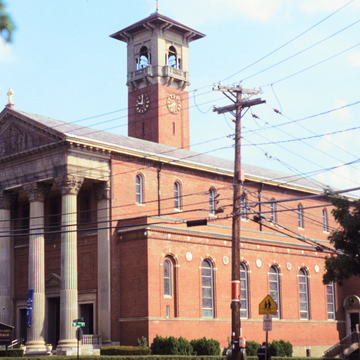With the construction of mills along the Charles River in Newton Upper Falls, this village's large Irish population formed the first Catholic parish in Newton. Prominently located at the top of the hill above the river valley, this outstanding church dominates surrounding neighborhoods, which contain the highest concentration of early-nineteenth-century vernacular housing stock and the largest number of brick mills in Newton. Rather than the Gothic style commonly used for Catholic churches, architect Graham created a monumental classical edifice with a massive two-story Corinthian portico. The tympanum holds figures in bas-relief representing the vision of Mary Magdalene at Lourdes. With no steeple or dome, the church features instead an Italian Renaissance campanile with balconies and a hipped roof with wide overhanging eaves. F. X. Zettler of Munich fabricated the stained glass windows, some of which were donated by the local Saco-Lowell Machine Company Mill. On an adjoining lot, Thomas G. O'Connell, a prominent Catholic architect better known for his Gothic buildings, designed the parish rectory (1938–1943, 270 Eliot Street) in the Georgian Revival style.
You are here
Mary Immaculate of Lourdes Church
If SAH Archipedia has been useful to you, please consider supporting it.
SAH Archipedia tells the story of the United States through its buildings, landscapes, and cities. This freely available resource empowers the public with authoritative knowledge that deepens their understanding and appreciation of the built environment. But the Society of Architectural Historians, which created SAH Archipedia with University of Virginia Press, needs your support to maintain the high-caliber research, writing, photography, cartography, editing, design, and programming that make SAH Archipedia a trusted online resource available to all who value the history of place, heritage tourism, and learning.


